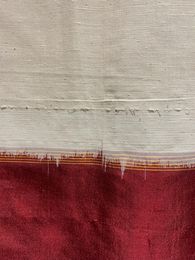Salman Rushdie breathes life to the forgotten goddess Pampa Devi in his novel Victory City (2023). Rushdie’s Pampa is a woman who is reborn after her mother walks into the embers of sati. She prays to live forever and is granted a life of 247 years, during which she will build and rule over the most beautiful city in the world, Bisnaga or ‘victory city’. After she dies, the city will be in ruins. Bisnaga is based on Vijayanagara in Karnataka. Pampa is another name for Parvati, hoping to entice a meditating Shiva into matrimony. It is also the old name for the river Tungabhadra, and the ancient moniker of Hampi, a UNESCO World Heritage site.
It is no surprise that textile advocate Lavina Baldota named her newest exhibition ‘Pampa: Textiles of Karnataka’, which took place at the 17th century stone-lined Mantappa exhibition centre in Hampi Bazaar. It’s just a few feet from the revered Virupaksha temple, which has a small home for Pampa Devi in its compound.
It is opportune that the exhibition, co-curated by Baldota along with Pragati Thakur, Mayank Kaul, Nupur Saxena and Priya Saxena, arrived in the week that celebrated women the world over. The textiles of Karnataka, even though largely woven by men, are nothing if not an homage to the working girls in the fields. Humble hand-woven cottons with slim borders that sought no attention to themselves. They stood out only because of their vivid natural colours: madder red, turmeric yellows, vegetal greens and nilambari navys that came from indigo. Decoration came from geometric squares or neat stripes patterned into the cloth.
The hero sari is the ilkal of the Bagalkot area, an ancient 8th century weaving technique that used cotton in the body and silk in the pallu. Then, there is also the ‘khann’, a new discovery for me, which is a shiny geometric grid-style weave in a fabric woven especially to make blouses. Baldota says both the ilkal and khann come from the Chalukya dynasty.
In the shimmer and shine of Benaresis of the north and Kanjeevarams of the south, the quiet ilkal doesn’t get much attention. But it is a connoisseur’s must-have.
The specialty of the ilkal is that the body warp and the pallu warp are hand-looped together on the loom itself, in a technique called the ‘tope teni’. Sometimes a ‘kondi’, or a three-shuttle technique, is used to change the fabric composition from cotton to silk. Secondly, the pallu will always have red in it, and have a triangle shaped to resemble a temple dome. The tope teni pallu is greatly respected and is considered to be a symbol of Karnataka textiles. Traditional borders are called chikki, gomi, jari, gadidadi or the modern gayathri.
The local legend Ramesh Ayodi has visited us at The Kishkinda Trust NGO in nearby Anegundi. I have fallen in love with and purchased a very modern and minimalist black-white sari from him from the Kishkinda shop, and am showing it to my friends. In the compound, a lady artisan tells me she made the sari. I tell her she is mistaken as I bought it from Ramesh. “We husband-wife,” she replies, indicating they made the sari together.
In much of India, the ‘weaver’ is the man. But his assistant is always his wife. She is often the spinner and the bobbin roller. She sets up all the pre-loom yarns for him first, until he finally sets up the yarn in the wooden frame of the loom and begins his clickety-clack weaving. The handwoven sari is actually the work of Shiva and Parvati then. But Parvati, or Pampa, remains in the shadows.
X@namratazakaria


